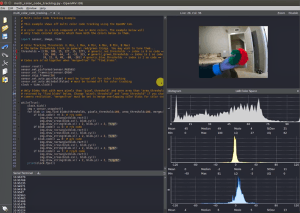OpenMV Cam – An Iintelligent Eye For Your Embedded Projects
July 18, 2018
on
on
 Nowadays, what functions can be expected from incorporating machine vision in DIY embedded projects at reasonable cost? The multitude of processes involved far exceed the capabilities of simple sensors. We may need to detect motion in a scene by looking at what changes from frame to frame (Frame Differencing). We also need to single out at least 16 colours at a time in an image (Colour Tracking). Detecting groups of colors would be great too (Marker Tracking). Then we also need to detect faces in the viewed image and detect a person's gaze (Face Detection & Eye Tracking). In many applications, recognising and reading QR Codes and other barcodes are valuable functions too (QR Code & Data Matrix & Linear Barcode Detection/Decoding). As are detecting geometric figures and infinite or non-infinite length line (Line, Rectangle, Circle Detection). Recognizing pre-saved images is yet another resourceful asset (Template Matching). Last but not least, we should mention the obvious image capture functions (Image & Video Recording).
Nowadays, what functions can be expected from incorporating machine vision in DIY embedded projects at reasonable cost? The multitude of processes involved far exceed the capabilities of simple sensors. We may need to detect motion in a scene by looking at what changes from frame to frame (Frame Differencing). We also need to single out at least 16 colours at a time in an image (Colour Tracking). Detecting groups of colors would be great too (Marker Tracking). Then we also need to detect faces in the viewed image and detect a person's gaze (Face Detection & Eye Tracking). In many applications, recognising and reading QR Codes and other barcodes are valuable functions too (QR Code & Data Matrix & Linear Barcode Detection/Decoding). As are detecting geometric figures and infinite or non-infinite length line (Line, Rectangle, Circle Detection). Recognizing pre-saved images is yet another resourceful asset (Template Matching). Last but not least, we should mention the obvious image capture functions (Image & Video Recording).
High-level Python scripts
By offering all these functions and more, the OpenMV Cam can make machine vision applications a reality for you too. OpenMV Cam is controlled by an STM32F765VI ARM Cortex M7 processor. The MicroPython operating system allows the use of high-level Python scripts. Take full advantage of the powerful Python language and its capabilities with machine vision algorithms. You retain full control over your OpenMV Cam and its I/O pins (12 Mb/s USB, microSD, SPI, I2C, CAN, TX/RX Asynchronous Serial Bus).When plugged in into your PC, your OpenMV Cam will appear as a Virtual COM Port and a USB Flash Drive.
Read full article
Hide full article



Discussion (0 comments)